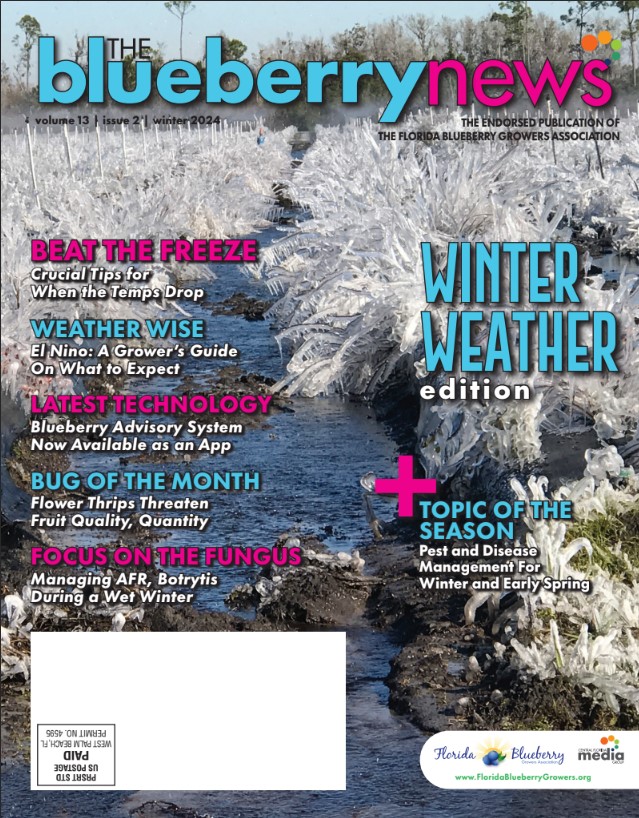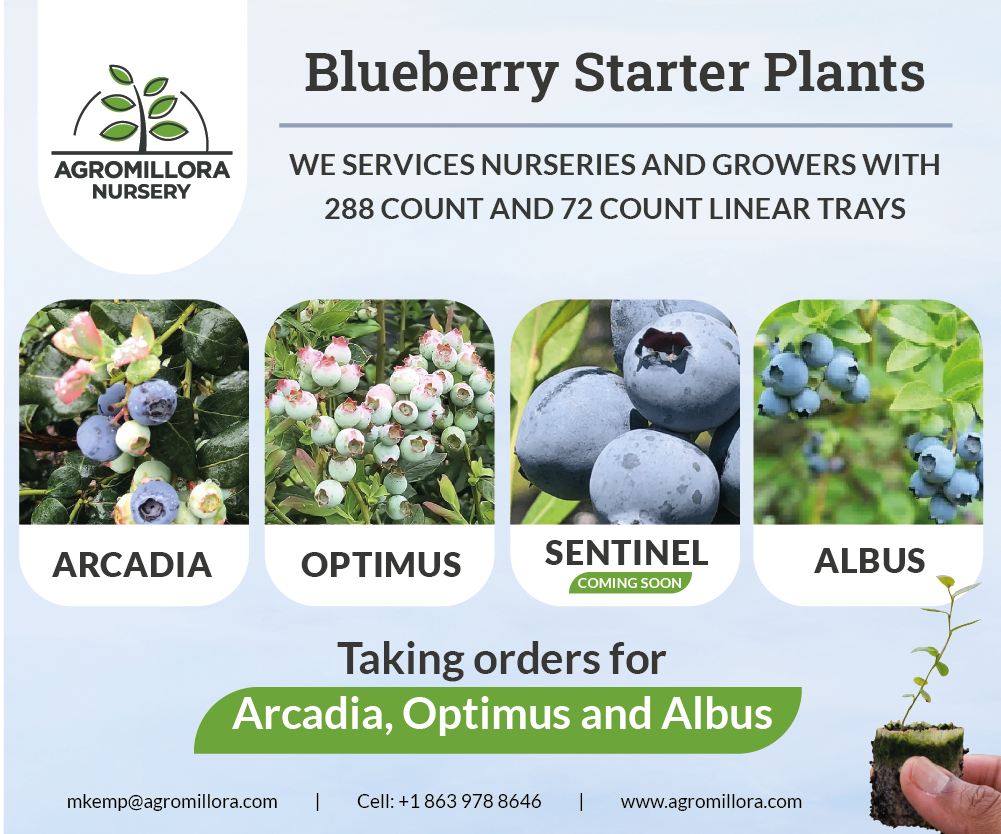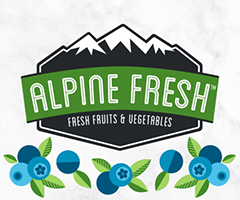Blueberry Advisory System Now Available as a Phone App
The Blueberry Advisory System (BAS) is a weather-based alert system that signals Florida blueberry growers when environmental conditions are favorable for the development of anthracnose fruit rot (AFR) and provides other data to help growers manage this disease.
AFR, also called ripe rot, is a fungal disease that can damage blueberry fruit, resulting in sunken lesions, softening, shriveling, and rotting of berries, along with eruptions of salmon-orange masses of spores. Symptoms typically begin at the blossom end of the berry and cause the fruit to be unmarketable, affecting pack-out percentages and grower revenues. Infection can occur as early as bloom, with symptoms often not appearing until the fruit ripens or after it has been harvested and stored. Warm, wet weather is conducive to the development of AFR, with temperatures between 59-81°F (15-27°C) and leaf wetness duration of more than 12 hours the most favorable for infection.
Control of this disease depends primarily on protective fungicide applications, which many blueberry growers apply using a calendar-based method. Under this method, fungicide applications are made at regular intervals during fruit development, often every 14-21 days, which over the course of a season can be a significant cost. The BAS allows growers to target their fungicide sprays to those periods when the development of infection is more likely, in many cases decreasing overall applications for the season while achieving a comparable level of disease control. In field trials on nine blueberry farms over the 2018-2019 seasons, the BAS was shown to provide comparable levels of AFR control in most cases (when conditions were favorable for AFR development) with fewer fungicide applications compared to existing grower practices. Growers can also use these risk assessments to choose whether to use a less expensive fungicide (such as Captan) when disease risk is moderate, or a more expensive product that may have greater efficacy during periods of high risk.
The BAS was originally developed for the AgroClimate web platform (https://cloud.agroclimate.org/tools/bas/), but is now also available as a mobile phone app, for both iOS and Android operating systems.
iOS: https://apps.apple.com/br/app/blueberry-advisory-system/id6464521352
Android: https://apps.apple.com/br/app/blueberry-advisory-system/id6464521352
The first screen of the BAS app shows a map of the blueberry producing regions in Florida and southern Georgia, with the current disease risk level for all weather stations included in the system that belong to the Florida Automated Weather Network (FAWN) and Georgia Automated Environmental Monitoring Network (AEMN). AFR risk levels are represented by colors and letters: green means “Low Risk,” yellow means “Moderate Risk,” and red means “High Risk” for anthracnose, represented by the letter “A.” Stations in “gray” are not updated, having no data during the last 24 hours and are “grayed out” to avoid conveying outdated information that may lead to wrong decisions. Growers can select a weather station to display a panel at the bottom of the screen showing the risk levels for that location and the time at which the information was last updated. From this screen growers also have the option to click on the disease risk level icon to visualize risk level simulations over the last 30 days and a forecast for the next two days. The forecast for the next two days appears on the right side of the screen. Users can roll the graph horizontally back and forth to visualize the forecast or the risk level for any day during the previous 30 days. Visualization of risk levels prior to the last 30 days are available only in the web version of BAS.
Growers can also check for spray conditions for the next 24 hours based on the NWS forecast for the selected weather station. Although default threshold values of wind speed, rain probability, humidity, and air temperature are provided to categorize spray conditions as “good,” “fair,” and “bad,” users can adjust these thresholds by clicking on the top right corner icon on the screen.
Figure 1. Screen captures of the Blueberry Advisory System showing the location of the weather stations (FAWN and AEMN) available in the system and specific information for the Dade City station.
Figure 2. BAS screens showing the spray conditions for the next 24 hours for the selected station (Dade City) and the adjustment thresholds screens for wind speed and air temperature that can be accessed when clicking on the adjustment icon highlighted in a red circle in the top right corner.
The AgroClimate laboratory at the University of Florida Agricultural and Biological Engineering Department is constantly working to provide weather-based solutions that benefit growers in Florida and the southeastern US. We gratefully acknowledge the support of the USDA Southeast Climate Hub for the development of this app.
CREDITS:
DOUG PHILLIPS, Blueberry Extension Coordinator, UF/IFAS
&DR. CLYDE FRAISSE, Professor, Agrometeorology, UF/IFAS





